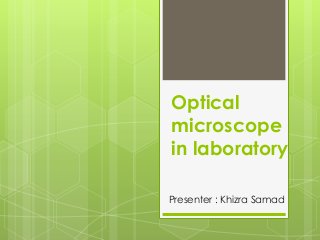Optical microscope in laboratory
•Transferir como PPTX, PDF•
7 gostaram•6,774 visualizações
Denunciar
Compartilhar
Denunciar
Compartilhar

Recomendados
This presentation describes the use of a Shimadzu UV-2600 UV-Vis Spectrophotometer coupled to a standard optical microscope via an optical fiber relay system to evaluate small filter samples approximately 1–2 mm in width.
For more information, please go to ssi.shimadzu.com. Thanks for viewing.
Micro Sample Measurement Using UV-Vis and Standard Optical Microscope

Micro Sample Measurement Using UV-Vis and Standard Optical MicroscopeShimadzu Scientific Instruments
Recomendados
This presentation describes the use of a Shimadzu UV-2600 UV-Vis Spectrophotometer coupled to a standard optical microscope via an optical fiber relay system to evaluate small filter samples approximately 1–2 mm in width.
For more information, please go to ssi.shimadzu.com. Thanks for viewing.
Micro Sample Measurement Using UV-Vis and Standard Optical Microscope

Micro Sample Measurement Using UV-Vis and Standard Optical MicroscopeShimadzu Scientific Instruments
Mais conteúdo relacionado
Destaque
Destaque (7)
Mais de Khizra Sammad
Mais de Khizra Sammad (20)
A PRACTITIONER'S GUIDE TO SOFTWARE TEST DESIGN [Summary]![A PRACTITIONER'S GUIDE TO SOFTWARE TEST DESIGN [Summary]](data:image/gif;base64,R0lGODlhAQABAIAAAAAAAP///yH5BAEAAAAALAAAAAABAAEAAAIBRAA7)
![A PRACTITIONER'S GUIDE TO SOFTWARE TEST DESIGN [Summary]](data:image/gif;base64,R0lGODlhAQABAIAAAAAAAP///yH5BAEAAAAALAAAAAABAAEAAAIBRAA7)
A PRACTITIONER'S GUIDE TO SOFTWARE TEST DESIGN [Summary]
Último
Último (20)
The architecture of Generative AI for enterprises.pdf

The architecture of Generative AI for enterprises.pdf
Slack (or Teams) Automation for Bonterra Impact Management (fka Social Soluti...

Slack (or Teams) Automation for Bonterra Impact Management (fka Social Soluti...
Mission to Decommission: Importance of Decommissioning Products to Increase E...

Mission to Decommission: Importance of Decommissioning Products to Increase E...
Measures in SQL (a talk at SF Distributed Systems meetup, 2024-05-22)

Measures in SQL (a talk at SF Distributed Systems meetup, 2024-05-22)
Software Delivery At the Speed of AI: Inflectra Invests In AI-Powered Quality

Software Delivery At the Speed of AI: Inflectra Invests In AI-Powered Quality
Exploring UiPath Orchestrator API: updates and limits in 2024 🚀

Exploring UiPath Orchestrator API: updates and limits in 2024 🚀
SOQL 201 for Admins & Developers: Slice & Dice Your Org’s Data With Aggregate...

SOQL 201 for Admins & Developers: Slice & Dice Your Org’s Data With Aggregate...
Optimizing NoSQL Performance Through Observability

Optimizing NoSQL Performance Through Observability
Knowledge engineering: from people to machines and back

Knowledge engineering: from people to machines and back
PLAI - Acceleration Program for Generative A.I. Startups

PLAI - Acceleration Program for Generative A.I. Startups
De-mystifying Zero to One: Design Informed Techniques for Greenfield Innovati...

De-mystifying Zero to One: Design Informed Techniques for Greenfield Innovati...
In-Depth Performance Testing Guide for IT Professionals

In-Depth Performance Testing Guide for IT Professionals
To Graph or Not to Graph Knowledge Graph Architectures and LLMs

To Graph or Not to Graph Knowledge Graph Architectures and LLMs
Kubernetes & AI - Beauty and the Beast !?! @KCD Istanbul 2024

Kubernetes & AI - Beauty and the Beast !?! @KCD Istanbul 2024
10 Differences between Sales Cloud and CPQ, Blanka Doktorová

10 Differences between Sales Cloud and CPQ, Blanka Doktorová
Integrating Telephony Systems with Salesforce: Insights and Considerations, B...

Integrating Telephony Systems with Salesforce: Insights and Considerations, B...
Key Trends Shaping the Future of Infrastructure.pdf

Key Trends Shaping the Future of Infrastructure.pdf
Free and Effective: Making Flows Publicly Accessible, Yumi Ibrahimzade

Free and Effective: Making Flows Publicly Accessible, Yumi Ibrahimzade
UiPath Test Automation using UiPath Test Suite series, part 1

UiPath Test Automation using UiPath Test Suite series, part 1
Optical microscope in laboratory
- 1. Optical microscope in laboratory Presenter : Khizra Samad
- 2. The optical microscope, often referred to as the "light microscope“. It is a type of microscope which uses visible light and a system of lenses to magnify images of small samples. Optical microscopes are the oldest design of microscope and were possibly designed in 17th century. Basic optical microscopes can be very simple, but there are many complex designs which aim to improve resolution and sample contrast.
- 3. Cont.. Historically optical microscopes were easy to develop and are popular because they use visible light so that samples may be directly observed by eye. The image from an optical microscope can be captured by normal light-sensitive cameras to generate a micrograph. Originally images were captured by photographic film Modern developments in CMOS and charge-coupled device (CCD) cameras allow the capture of digital images. Purely digital microscopes are now available which use CCD camera to examine a sample, showing the resulting image directly on a computer screen without the need for eyepieces.
- 4. A modern microscope with a mercury bulb for fluorescence microscopy. The microscope has a digital camera, and is attached to a computer.
- 5. Working 1. 2. An optical microscope consists of the following two major basic functions. Creating a Magnified Image of a Specimen (observation optical system) Illuminating a Specimen
- 6. Creating a Magnified Image of a Specimen 1. 2. 3. The function to create a magnified image of a specimen consists of three basic functions : Obtaining a clear, sharp image Changing a magnification Bringing into focus". An optical system for implementing these functions is referred to as an observation optical system
- 7. Illuminating a Specimen The function to illuminate a specimen consists of three basic functions : 1. supplying light 2. collecting light 3. changing light intensity An optical system for implementing these functions is referred to as an illumination optical system. The illumination optical system effectively collects light emitted from the light source and leads the light to a specimen to illuminate it.
- 8. Uses Extensively used in microelectronics, nanophysics, biotechnology, pharmaceutics research, mineralogy and microbiology. Used for medical diagnosis, when dealing with tissues, or in smear tests on free cells or tissue fragments. In industrial use, binocular microscopes are common. In certain applications, long-working-distance or longfocus microscopes[are beneficial. An item may need to be examined behind a window, or industrial subjects may be a hazard to the objective. Such optics resemble telescopes with close-focus capabilities
